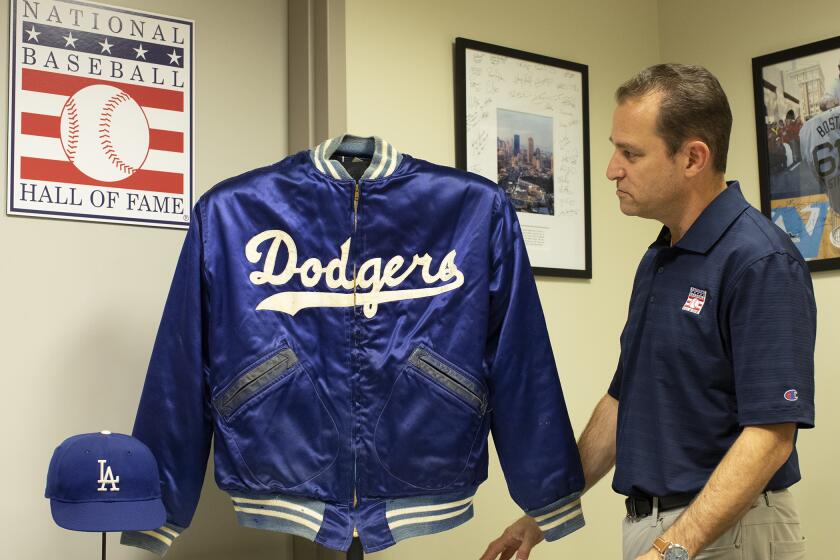It’s Not Easy Being a Fan or Player These Days
- Share via
The fan who threw a cup of beer at Jason Giambi in Oakland obviously wasn’t thinking clearly. With the price of suds at the ballpark, it would have been a lot cheaper to toss a few peanuts instead.
Or maybe some spare change, like the Detroit fan who hit Allen Iverson with a quarter during a playoff game last month in Auburn Hills, Mich.
That seemed cheap enough at the time, until a fellow fan pointed the guy out to police and he was arrested on charges that could land him up to 90 days in jail.
It’s dangerous being a player these days, where you can be at risk chasing a ball down in the right-field corner or simply walking back to the dugout after making yet another out.
It’s not all that easy being a fan, either. Just ask Jennifer Bueno, whose nose was broken when Texas Rangers reliever Frank Francisco threw a folding chair in the stands last year in Oakland, or the spectators the Dodgers bullpen went after one day at Wrigley Field five years ago.
Luckily, Giambi is off the juice these days so the latest incident of fan rage over the weekend didn’t spark any ‘roid rage. Giambi is already so beaten down that he seemed to accept getting a beer tossed in his face as simply another indignity he will have to put up with the rest of his well paid career.
“It’s over,” Giambi said a day later. “There’s nothing to talk about.”
Actually, there’s plenty to talk about, and both fans and players should start listening before things really begin getting out of hand.
The November brawl in Detroit may have shocked the nation with the graphic video of Ron Artest and his Indianapolis teammates tangling with fans, but it seems as if the lessons learned on both sides of the court have already been forgotten.
Maybe that’s because penalties usually aren’t too severe, though that might change when justice is finally done in Detroit.
“They think they can get away with things, first of all. There haven’t been enough consequences meted out over the years,” said Richard Lapchick, a sports sociologist who runs the Institute for Diversity and Ethics in Sport at the University of Central Florida. “Fans think somehow the ticket is a license to behave as badly and rudely as they want to.”
Yankees outfielder Gary Sheffield said much the same thing after charges were dropped against a Red Sox fan he says hit him in the face while he went after a ball last month at Fenway Park.
“If you feel that’s setting an example, so be it,” Sheffield said.
Player-fan confrontations, of course, have been around as long as organized sports. From the day the first ticket was sold, fans discovered the art of heckling players.
During the 1912 season, Ty Cobb got so fed up with the heckling of a New York Highlanders’ fan that he charged into the stands after the man. The fan had lost part of his hand in an industrial accident and could not defend himself as Cobb gave him a vicious beating.
In 1961, two fans ran out of the right-field stands onto the field at Yankee Stadium, only to get punched and kicked by Cleveland center fielder Jimmy Piersall.
But the recent spate of incidents is troubling, mainly because it’s likely indicative of deeper problems in the relationships between today’s fans and players.
Teams are partly to blame because they sell high-priced seats next to courts and fields where players can’t help but occasionally collide with fans. They encourage fans to hate the other team, then compound the problem by selling them all the beer they can drink.
Players seldom help their own cause. Most refuse to even try to relate to the fans who actually do pay their salaries, while some think nothing of giving fans an obscene gesture when things go bad. Others go even further, as Albert Belle did in 1991 when he threw a ball at a heckling fan and hit him in the chest.
“There’s a joint responsibility here. The athletes sometimes are arrogant to the fans and very often present themselves as being distant,” Lapchick said. “The fan sees the athlete making all this money living a lifestyle the fan would like to lead himself. There’s kind of a hostility set up between the two groups that carries into the arena.”
Lapchick traces the bad behavior back to the early 1990s, from which time he says there has been a general decline in civility in every part of the nation’s social fabric.
That was evident recently even at Dodger Stadium, a place where mild-mannered fans for decades did little more outrageous than listen to Vin Scully on their transistor radios and bounce beach balls around.
Last year, though, fans got in a bottle throwing altercation with outfielder Milton Bradley, while earlier this month a game was interrupted when fans enjoying a $2 ticket promotion in the left-field pavilion littered the field with debris.
It’s a sign of the times, and one we may as well get used to.
Because, until both sides learn to behave, the worst is yet to come.
More to Read
Are you a true-blue fan?
Get our Dodgers Dugout newsletter for insights, news and much more.
You may occasionally receive promotional content from the Los Angeles Times.








